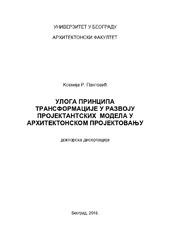Role of the transformation principles in the development of design models in architectural design
Улога принципа трансформације у развоју пројектантских модела у архитектонском пројектовању
| dc.contributor.advisor | Nikezić, Ana | |
| dc.contributor.other | Vujović, Milan | |
| dc.contributor.other | Marić, Igor | |
| dc.creator | Pantović, Ksenija R. | |
| dc.date.accessioned | 2019-11-03T13:17:06Z | |
| dc.date.available | 2019-11-03T13:17:06Z | |
| dc.date.issued | 2016 | |
| dc.identifier.uri | http://eteze.bg.ac.rs/application/showtheses?thesesId=3512 | |
| dc.identifier.uri | https://fedorabg.bg.ac.rs/fedora/get/o:12208/bdef:Content/download | |
| dc.identifier.uri | http://vbs.rs/scripts/cobiss?command=DISPLAY&base=70036&RID=48119311 | |
| dc.identifier.uri | http://nardus.mpn.gov.rs/123456789/6210 | |
| dc.identifier.uri | https://raf.arh.bg.ac.rs/handle/123456789/376 | |
| dc.description.abstract | Rapid and complex changes in all spheres of today's society define a fluid context in which contemporary architecture is formed and they assign it attributes of multidisciplinary practice with a constant idea of change. Adaptation to these changes results not only in dynamic redefinition of architect's role, but in redefinition of the design paradigm itself as well, by reassessing it and establishing new design principles. The objective is to position a certain transformation principle within the architectural discourse through the process of systematization and classification in order to indicate its evolving course, influence and its importance in the progression of both society and architectural theory and practice from various Avant-garde movements during the 20th century, to the digital paradigm development. By further examining of the transformation principles in architectural discourse, the aspects of applying these principles are defined in purpose of adapting buildings to dynamical alterations of the context and needs of users. With regards to this issue, by perceiving transformation with all its complexities, the following principles can be defined in several categories: mobility, ephemerality, modularity, prefabrication, perceptive transformation, universality, open plan, interaction and improvisation. Examining ubiety, character and relations among defined principles through the analyses of several architecturally relevant examples, this PhD thesis investigates influence and implementation of the transformation principles in the evolvement of design models. The research platform is referenced to Pritzker prize laureates since the year 2000, with particular attention drawn to those laureates who implement the transformation principles in their theoretical work as well. The affirmation level of transformation principles in the analyzed projects demonstrates their emerging relevance as the life standards are changing, therefore it becomes integrated with the methodological apparatus in the process of contemporary architectural design. The performed analysis of the examples indicates that contemporary approach in the architectural design requires elasticity of a design model whose integrated part is a transformation principle... | en |
| dc.description.abstract | Рапидне и комплексне промене у свим аспектима савременог друштва дефинишу флуидни контекст у коме настаје савремена архитектура и дају јој обележја мултидисциплинарне праксе са константном идејом о промени. Прилагођавање овим променама резултира динамичним редефинисањем како улоге архитекте, тако и саме пројектантске парадигме, преиспитивањем и формулацијом нових пројектанских принципа. Циљ је да се кроз систематизацију и класификацију позиционира принцип трансформације у архитектонски дискурс чиме се указује на пут развоја, заступљеност и његов значај у целокупном развоју како друштва, тако и архитектонске теорије и праксе од различитих авангардних покрета током ХХ века, па све до развоја парадигме дигиталног. Дубљим испитивањем принципа трансформације у архитектонском дискурсу, дефинишу се начини примене овог принципа у циљу прилагођавања објеката динамичним променама контекста и потреба корисника. У том контексту, сагледавајући трансформацију у свој својој сложености идентификују се следећи принципи: мобилност, ефемерност, модуларност, префабрикација, перцептивна трансформација, универзалност, отворени план, интерактивност и импровизација... | sr |
| dc.language | sr | |
| dc.publisher | Универзитет у Београду, Архитектонски факултет | |
| dc.relation | info:eu-repo/grantAgreement/MESTD/Technological Development (TD or TR)/36035/RS// | |
| dc.rights | openAccess | |
| dc.rights.uri | https://creativecommons.org/licenses/by-nc-nd/4.0/ | |
| dc.source | Универзитет у Београду | |
| dc.subject | transformation principles | en |
| dc.subject | contemporary design model | en |
| dc.subject | method | en |
| dc.subject | concept | en |
| dc.subject | context | en |
| dc.subject | принцип трансформације | sr |
| dc.subject | савремени пројектантски модел | sr |
| dc.subject | метод | sr |
| dc.subject | концепт | sr |
| dc.subject | контекст | sr |
| dc.title | Role of the transformation principles in the development of design models in architectural design | en |
| dc.title | Улога принципа трансформације у развоју пројектантских модела у архитектонском пројектовању | sr |
| dc.type | doctoralThesis | |
| dc.rights.license | BY-NC-ND | |
| dcterms.abstract | Никезић, Aна; Вујовић, Милан; Марић, Игор; Пантовић, Ксенија Р.; Uloga principa transformacije u razvoju projektantskih modela u arhitektonskom projektovanju; | |
| dc.identifier.fulltext | https://raf.arh.bg.ac.rs//bitstream/id/916/373.pdf | |
| dc.identifier.rcub | https://hdl.handle.net/21.15107/rcub_nardus_6210 | |
| dc.type.version | publishedVersion |

